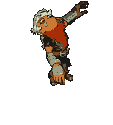|
I need some homework. Lots of things happening in that annoying distraction called "life" and I want a simple project which doesn't involve keeping much state in my head that I can work on in bits and pieces. just something to keep my brain from atrophying. About the only prerequisites are that it doesn't use proprietary tools and that it be simple. It doesn't need to be great. It can be utterly silly for all it matters. I just want to see some sort of result instead of all these weird projects I have which do lots but don't really show any output.
|
|
|
|

|
| # ? May 11, 2024 19:33 |
|
General_Failure posted:I need some homework. Lots of things happening in that annoying distraction called "life" and I want a simple project which doesn't involve keeping much state in my head that I can work on in bits and pieces. just something to keep my brain from atrophying. Chosen at random from my game idea files: SimPlankton e: I guess I actually made this at one point; I made a pretty cool, simple little A-Life sim once that used a simple little machine language to power a 2d grid of "bugs". Each instruction was three bytes of data, with a bunch of basic "ops" like Move and Eat. I'd start each but with something like 256 bytes of memory with a simple program like "move at random", "eat", and every so often I'd let the fattest bugs breed by copying themselves with random numerical mutation, and kill off the thinnest bugs. It was pretty astounding how quickly they would find bugs in my opcodes and generate reasonably complex behavior. Like I added a "push" opcode that would push food out of an adjacent bug. When I ran it, in about 1 second it devolved into just a few single pixels, and I was pretty confused. Debugging the opcode, I realized that it didn't subtract the total when it pushed the food out, so the most adaptive strategy was to sit on top of each other pushing food out of each other. They figured it out in just a handful of culling cycles. Pretty neat. e2: This project really didn't take all that much time and was really awesome, you should do something like it. Unormal fucked around with this message at 03:32 on Aug 6, 2012 |
|
|
|
General_Failure posted:I need some homework. Lots of things happening in that annoying distraction called "life" and I want a simple project which doesn't involve keeping much state in my head that I can work on in bits and pieces. just something to keep my brain from atrophying. Make a shoot'em up boss battle. Make it really loving hard.
|
|
|
|
Both brilliant ideas! Thanks. Because you both went to the trouble of replying I'll tell you why I like them. Boss battle: Because it is a simple idea but requires effective use of display, control, video and audio, and timers. SimPlankton, or whatever you feel like calling the CA. It's an overlap of things I've got experience with. I've done plenty with CAs and ALife. I have also written "fantasy VMs" for fun. Even wrote one in QuickBASIC 4.5 many aeons ago which was essentially an extremely simplified design with something like 16 opcodes which were inspired by the 6502. It had 256 bytes of RAM, a vector based display, keyboard input and memory paging. Even wrote a separate monitor / assembler sort of program to make writing code easier. While it's not hard to write things in hex it made reading the self modifying nightmare easier. Um, I've done non-BASIC ones too. It's just that one was a bit of an oddity and fits the theme of the idea.
|
|
|
|
General_Failure posted:Both brilliant ideas! Thanks. So just combine them and have the culling function be Ganon showing up on-screen to wreck some CA lives.
|
|
|
|
Unormal posted:So just combine them and have the culling function be Ganon showing up on-screen to wreck some CA lives. There is nothing wrong with CA based NPCs.
|
|
|
|
...unless you care about game balance.
|
|
|
|
Unormal posted:I mean yes, theoretically of course they are, but quite different in syntax. It has prototypical inheritance, which isn't that unusual.
|
|
|
|
OK, now I've got another bee in my bonnet about making a strategy game about solar system colonization. The primary interface would be a 3D map of the solar system where you can zoom in on planets to do poo poo, and I'm currently considering how to implement a minimal prototype of this interface. I bought a Pygame book because I really like the idea of using a scripting language for the game dynamics (very nice for a game with complicated economics rules that need to be tweaked a lot, for instance), but I'm pretty concerned about the limitations of Pygame when it comes to 3D graphics. I read that Pygame doesn't provide shading for instance, which is something the interface would obviously need if you're going to have decent-looking planetary rotation. I know it's a pretty open-ended problem, but what platforms should I be looking at? I guess my main consideration is having a language I like to write in - i.e. Python or something like it. I know I'm being picky here but I had a job maintaining C++ code at one point and I can't imagine spending tons of free time on something so unfun. I'm not entirely sure what my technical requirements are - seems like Pygame would handle the basics except for some 3d graphics aspects. OS X compatibility would be nice and so would a healthy ecosystem, with example source code I can read and documentation specific to that development platform.
|
|
|
|
Vivian Darkbloom posted:OK, now I've got another bee in my bonnet about making a strategy game about solar system colonization. The primary interface would be a 3D map of the solar system where you can zoom in on planets to do poo poo, and I'm currently considering how to implement a minimal prototype of this interface. You could always look at unity. Code in javascript or C#, does a lot of the boring stuff for you.
|
|
|
|
I've been working on rendering my billboards for things like ammo pickups and enemies, and I can't quite seem to get it right. My approach is to use a unit billboard (1x1 triangle fan) that I translate, scale, then rotate to face the camera. First, translate the billboard to the object's position (from 0,0,0). Next, rotate around the y axis using atan2 of cameraPos - objectPos on the XZ plane. Then scale the billboard to the size of the object. That should get me the Model matrix, right? Finally, multiply the view matrix of the camera. My camera's ModelView matrix is rotation and (inverse?) translation of the camera. (And of course the projection matrix.) Currently, the level's world and local coordinates are the same, but that's not going to be the case for the billboards, and if I remember right I need to create the matrix to go from local->world for each billboard.
|
|
|
|
Are you trying to make the surface perpendicular to the camera, or facing the camera as much as possible while rotating about a single axis? i.e. if you looked at it from the top, would you see nothing, or see the sprite facing you?
|
|
|
|
Pfhreak posted:I've been working on rendering my billboards for things like ammo pickups and enemies, and I can't quite seem to get it right. My approach is to use a unit billboard (1x1 triangle fan) that I translate, scale, then rotate to face the camera. Here's how I do billboards (pseudocode): code:HiriseSoftware fucked around with this message at 20:03 on Aug 6, 2012 |
|
|
|
Is it possible to run pygame over ssh? I am logging into my unbuntu system at home through putty and have run into an issue. Whenever I run a pygame file it outputs this directly to the terminal. http://i.imgur.com/MmojQ.png Any thoughts?
|
|
|
|
|
OneEightHundred posted:Are you trying to make the surface perpendicular to the camera, or facing the camera as much as possible while rotating about a single axis? i.e. if you looked at it from the top, would you see nothing, or see the sprite facing you? Well, it would seem the former would make more sense for enemies. I'm remaking an old 2.5D game with some limited camera height adjustment.
|
|
|
|
Don Mega posted:Is it possible to run pygame over ssh? I am logging into my unbuntu system at home through putty and have run into an issue. Whenever I run a pygame file it outputs this directly to the terminal. http://i.imgur.com/MmojQ.png Err, what are you actually trying to do? Is it an ascii based console game, or does it render OpenGL to the display? If the former, you may need to set your terminal type correctly. If the latter, you need to set your ubuntu system to forward the display to the box you are logging in with, and have an X11 instance to display it locally. It probably won't run that great since everything is being processed on your ubuntu system and not locally.
|
|
|
Azazel posted:Err, what are you actually trying to do? Is it an ascii based console game, or does it render OpenGL to the display?
|
|
|
|
|
I have some experience working with Unity, and I was thinking of working on a FPS next. I wonder if the UDK would be better suited for this and worth learning. It seems to have all of the 'FPS' bits built in which would speed development up quite a bit. Ideally, but not essentially, I'd also have an online component, this is also something UDK seems to have built in. Is UDK suitable for a one man, hopefully commercial venture? Or should I stick with Unity and build the FPS and networking parts from scratch?
|
|
|
|
Serenade posted:I have some experience working with Unity, and I was thinking of working on a FPS next. I wonder if the UDK would be better suited for this and worth learning. It seems to have all of the 'FPS' bits built in which would speed development up quite a bit. Ideally, but not essentially, I'd also have an online component, this is also something UDK seems to have built in. The UDK is a serious investment of energy and time to learn. Don't expect it to be 1/10th as user friendly as Unity is. If you are not a serious developer with serious experience developing games, it's much more likely that the UDK will break you. Make sure you are familiar with C++ before diving in. That said, the UDK does some pretty impressive things if you can make it work for you.
|
|
|
|
Pfhreak posted:The UDK is a serious investment of energy and time to learn. Don't expect it to be 1/10th as user friendly as Unity is. If you are not a serious developer with serious experience developing games, it's much more likely that the UDK will break you. Make sure you are familiar with C++ before diving in. Namely, you need to be working pretty narrowly within one of the genres you've seen UE3 do before. Which is to say, action side-scrollers, third person shooters, first person shooters, third/first person RPGs, etc. The further you go from that core, the more you'll hate life / run into brick walls that you've got to hack your way around. We started on UDK, and built a prototype - and then canned the entire thing and rebuilt it in Unity in half the time. In retrospect, we could have stayed with UDK, but it was still faster/easier to do in Unity. Now, if the game DOES fit within what UDK can do, and you're willing to learn the toolset, it's fantastic. It will produce visuals head and shoulders above anything you'll get out of Unity 3D, without some significant previous experience in graphical programming. In terms of useful experience, it's a wash. Unity 3D experience is great to have these days if you're looking at mobile space, UE3 experience is still great to have if you're looking in AAA space. UE4 is poised to take over consoles again with the next generation, so I can't see UDK experience becoming less useful any time soon. Shalinor fucked around with this message at 18:39 on Aug 8, 2012 |
|
|
|
So I'm hitting a bit of a wall design-wise with my 2D game/engine at the moment. The way I have it designed at the moment is that Worlds have Scenes, and Scenes have a list of SceneObjects which are pre-sorted in their draw order. Tilemaps and Sprites are both SceneObjects, so they can be ordered any which way so that you can have foreground and background tilemaps, and sprites can either go in front of or behind them (So you can have, say, an enemy that hides in the background and jumps into the foreground to attack). However I'm having a difficult time deciding how to change the sorting position of the objects for specific states, and/or where to place objects in the list that have been spawned through code. I'm trying to avoid having explicit background and foreground layers since it destroys a lot of the flexibility of the current tilemap system, like being able to overlap various separate tilemaps to minimize tilesets (So I don't have to have dirt, grass, dirt with rock, grass with rock and so on). At the moment I'm thinking of not making Sprites a SceneObject, and instead having SpriteLayers. In the example of an enemy jumping from the foreground to the background, the sprite could just get its current SpriteLayer and look for an earlier one in the list (Or a specifically named one), but I'm not sure about this as it'll require each scene (At least, the ones with the enemies on them) to have a SpriteLayer at the correct location with the correct name and it goes against my 'It just works' instincts. I feel like I'm vastly overthinking the problem, and there's probably some obvious solution that I've completely missed. edit: Like... uh, having a Z depth for each object to determine their draw order. Something obvious like that.
|
|
|
|
AntiPseudonym posted:edit: Like... uh, having a Z depth for each object to determine their draw order. Something obvious like that. Instead of concocting some kind of draw order for the layering, how about using an orthographic projection instead and just letting the hardware handle the depth from there?
|
|
|
|
I don't think that's what he asked; he asked how to manage the depth itself, not how to implement painter's algorithm/the depth buffer. It heavily depends on the game. In a game I wrote a long time ago, I had a Z depth integer, but I never liked that, as you would have sprite.depth = BACKGROUND_DEPTH + 5 /* hack: go above this other sprite */. Today, I think I'd simply define every depth to have semantics (background parallax 1, background parallax 2, background, sprite below, sprite, sprite above, foreground, foreground parallax 1, foreground parallax 2), and simply try to design my game around that.
|
|
|
|
Unity problem. I've just started learning unity and I'm currently prototyping a game. I'm having an issue with the physics. This snippet is set to model vehicles crashing at their top speed- http://livesplusplus.com/unitytest/unity-test.html The cars are being sent far too high up in the air for my liking and they seem to hang there for too long, it looks unrealistic. The cars have a simple box collider plus 4 wheel colliders, the mass of the cars is 2000 and they are set in motion using rigidbody.velocity. I've tried making gravity stronger but it pulls tipped over cars back to normal which I think isn't a nice aesthetic. Any ideas?
|
|
|
|
Fox1 posted:Unity problem. You either need to model the trucks a little differently, so that they don't tip over despite the higher gravity, or you need to throw in some fake forces. You could monitor for airborne objects and apply additional gravity-like force to them, for instance, or you could increase global gravity but add some logic to the vehicles to keep them from tipping back on their wheels all the time. (personally, I just use Controllers, and fake everything including gravity - it lets me tweak gameplay physics to be precise and more arcadey)
|
|
|
|
Fox1 posted:Any ideas? Like Shalinor says, the usual solution to car physics is to not actually use physics. It's [part of] why GTA: Vice City is more fun than GTA4.
|
|
|
|
Adding some -y velocity on impact already makes a huge difference, I'll keep tweaking, cheers guys.
|
|
|
|
I'm having a lot of trouble trying to animate asf/amc skeletons. I have reduced the problem down to something as simple as possible, by just drawing spheres at each bone. It works fine for drawing the skeleton in the bind pose by only using translation and no rotation. Problems happen when I try to animate it. I am using old style opengl. Pseudocode showing way I'm doing it now is something like this: code:FlyingDodo fucked around with this message at 17:28 on Aug 9, 2012 |
|
|
|
Fox1 posted:Any ideas? I think you need to adjust the physics materials to make the collisions WAY less elastic (I can't remember off the top of my head what unity calls the bounciness factor). Real automobiles have all sorts of crumple zones and deformation in a crash that absorbs energy that would otherwise hurl them into the air.
|
|
|
|
You've modeled the Hot Wheels-slow-motion-cars-crashing-into-each-other-commercial perfectly.
|
|
|
|
The biggest problem I've had when dealing with Physics in Unity was solved easily: I was trying to make a pinball game, but my pinball, technically being about 3 metres large, meant that physical impacts were strange and it'd move slowly in comparison to the world objects and not at all like an actual pinball. The key was to change what size unity thought it was dealing with - my memory's fuzzy, but somewhere in the physics settings you can change the physics scale or something like that. Try fiddling with that!
|
|
|
|
While we're on the subject of physics, does anybody know if Box2D could be coerced into doing CSG physics? Off the top of my head it SEEMS like something you could do with creative collision filtering, but I'm not sure if anybody's actually tried it. Would be nice for things like a curved corner. (Think N.)
|
|
|
|
DrMelon posted:The biggest problem I've had when dealing with Physics in Unity was solved easily: I was trying to make a pinball game, but my pinball, technically being about 3 metres large, meant that physical impacts were strange and it'd move slowly in comparison to the world objects and not at all like an actual pinball. My advice is, rather than changing Unity's scale, just build your game to fit Unity's default concept of scale. Not too hard, so long as you nail it early in greybox phase. Scale your elements up and down, see what effect it has on the sim, decide on a scale accordingly.
|
|
|
|
I want to make a roguelike in Python, with a text- or tileset-based interface. What would the best library for that be? Pygame, Pyglet, or something else?
|
|
|
|
Sam. posted:I want to make a roguelike in Python, with a text- or tileset-based interface. What would the best library for that be? Pygame, Pyglet, or something else? I'd go with libtcod, and I'd start here: http://roguebasin.roguelikedevelopment.org/index.php/Complete_Roguelike_Tutorial,_using_python%2Blibtcod
|
|
|
|
Wrote a bit on level generation on Hexatron over at my blog if anyone wants to check it out: http://scisbot.com/ Super simple stuff really, but it worked pretty well I thought so I think it's amazing.
|
|
|
|
Thinking of making a very simple text-based RPG with a simple GUI so players can click "Go Left" instead of typing it. What language would be best for this kind of thing? I've only really had experience with VB and Python.
|
|
|
|
PlatinumJukebox posted:Thinking of making a very simple text-based RPG with a simple GUI so players can click "Go Left" instead of typing it. What language would be best for this kind of thing? I've only really had experience with VB and Python. ... and there are certainly engines out there for narrative and text-based games, but I'm guessing you're wanting to build it up yourself?
|
|
|
|
Shalinor posted:If you're at all interested in web coding, that kind of game is a great fit for it. It'd be a fine excuse to learn HTML5/CSS, for instance, and a web-based game reduces user friction by quite a bit. Ideally. I don't think a pre-made engine would let me tinker around as much as I'd like. I hadn't really considered HTML, but I'll give it a look. Any good resources for this sort of thing?
|
|
|
|

|
| # ? May 11, 2024 19:33 |
|
Shalinor posted:If you're at all interested in web coding, that kind of game is a great fit for it. It'd be a fine excuse to learn HTML5/CSS, for instance, and a web-based game reduces user friction by quite a bit.
|
|
|
























